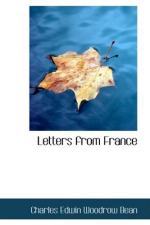It was interesting to see the difference of style. All three types of colonial woodsmen cut the tree almost breast high, but the Australian seemed to be the only one that took advantage of that understroke, with a hiss through the clenched teeth, which looks so formidable when you watch our timber-getters. It was a Canadian team which started. They cut coolly, and the one whom I watched struck one by his splendid condition. A wiry man, not thick-set, but well built and athletic, who never turned a hair. I think he was perhaps too cool to win. His comrades were not quite so fast as he. They cut the tree with a fairly narrow scarf, the top cut coming down at a steep angle, and the lower cut coming straight in to meet it, so that the upper end of the stump, when the tree falls, is left cut off as straight as a table top. Their first tree crashed in fourteen minutes, the next in fifteen, and then they all three tackled the last and toughest, which fell in twenty-one; fifty minutes altogether when the three times were added.
The next team was Australian. From the first rapid swing one’s anxiety was whether they could possibly stand the pace. They tackled the job so much more fiercely than the Canadians. I watched a young Tasmanian, his whole soul in it, brow wrinkled, and sweat pouring from his face. You would have thought that he was cutting almost wildly, till you noticed how every cut went home exactly on top of the cut before. These Australians—they were Western Australians mostly—made a wide scarf, the top cut coming down at an angle, and the lower cut coming up at a similar angle to meet it, making a wide open angle between the two. The odds would, I think, have been taken by most of those who went there as being in favour of the Canadians; and it was a great surprise when the three Australian trees were all down in thirty-one minutes and eight seconds.
The New Zealanders cut third. Their team consisted of Maoris. They did not seem to be cutting with the fire of the Australians. There was not the visible energy; their actions struck one as easier, and one doubted if their great, lithe, brown muscles were carrying them so fast.
Yet the time told the truth. Their three trees were down in twenty-two minutes and forty seconds, and no one else approached them. One Canadian team improved the Canadian time to forty-five minutes twenty-two seconds. The Maoris seemed mostly to cut with a narrower scarf even than the Canadians, both upper and lower cuts sloping downward at a narrow angle. In fairness it must be said that the Maoris had practised about six weeks, the Canadians and Australians about one week.
An Australian won the log-chopping competition; and the Canadians won with the crosscut saw. A New Zealander won the competition for style.
Later the men were mostly sitting watching the Frenchmen, workers in the forest, giving an exhibition cut. Two of a Canadian team were sitting on a log next to me, yarning in the slow, quizzical drawl of the Canadian countryman, when some of their mates sat down beside them. The man next me turned to them, and the next instant they were all talking French among themselves, talking it as their native tongue. Their officer, a handsome youngster, spoke it too. It was not till that moment that I realised that most of these Canadian woodsmen here were French.




